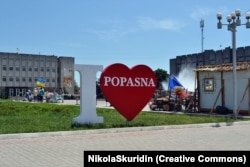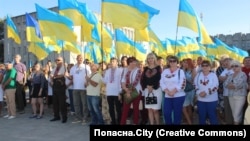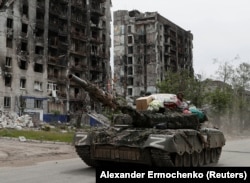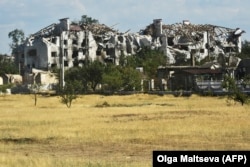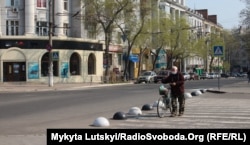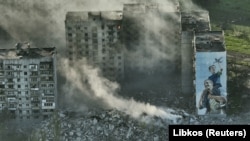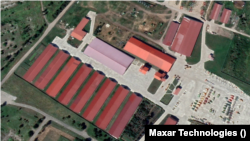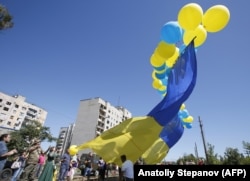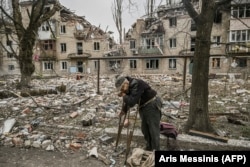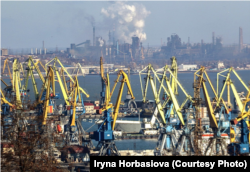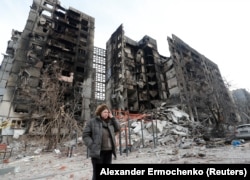Russia has delivered multiple public justifications for the full-scale invasion of Ukraine that President Vladimir Putin launched in February 2022, among them what it has called the "liberation" of Ukraine's eastern Donbas region, which Moscow had seized partial control of in 2014.
But Russia's all-out war on Ukraine -- which the Kremlin insists on calling a "special military operation" -- has decimated multiple cities and towns targeted in Moscow's ostensible "liberation" campaign, including those that had been rebuilt and thrived despite their proximity to the front line with Russian forces.
A new project by Donbas.Realities, a regional news outlet of RFE/RL's Ukrainian Service, looks at the fate of five towns and cities in eastern Ukraine following Russia’s full-scale invasion, including one that was not only nearly completely destroyed by Russian artillery and bombs, but also literally wiped from the map by Russian-installed occupying administrators.
Popasna
- Founded: 1878
- Population at start of 2022: ca. 20,000
- Current population: ca. 200, according to April 2023 data from the city’s wartime administration
Popasna is a town in the Luhansk region near the administrative border with the Donetsk region. After war broke out in the Donbas between the government and Russian-backed anti-Kyiv forces in 2014, Popasna was under occupation for nearly three months before it was retaken by Ukrainian forces.
In the ensuing years, the town was targeted by occasional Russian attacks from across the demarcation line with Russian-occupied areas. Nonetheless, Popasna was actively developing, including with international support.
Roman Vlasenko, head of the Popasna district administration from December 2014 to October 2016, says housing and social infrastructure were restored by 2017, and that the city managed to attract millions of dollars in investments.
Russia wiped Popasna from the map following the full-scale invasion of Ukraine that President Vladimir Putin launched last year. Russian forces rained dense artillery fire on the city, and street-level combat began there in the second half of April 2022. The Ukrainian Army withdrew from Popasna weeks later.
In August 2022, Russian occupation authorities indicated that Moscow would not rebuild Popasna. "There's not much point. The city really is almost completely destroyed," a Moscow-installed regional administrator said.
In March 2023, occupation authorities in the Luhansk region administratively erased Popasna's status as a city, incorporating it as one of numerous settlements within the Russian-controlled Ukrainian city of Pervomaysk.
The Popasna district, of which the eponymous city was the administrative center, was eliminated altogether by the Russian-installed administration.
Rubizhne
- Founded: 1895
- Population at start of 2022: ca. 55,000
- Current population: unknown as of May 31, 2023; (According to Luhansk-based journalist Oleksiy Artyukh, around 40,000 people lived in the entire Syevyerodonetsk district of the Luhansk region, where Rubizhne is located, in early May 2023)
Rubizhne is located on the left bank of the Siverskiy Donets River, near the cities of Syevyerodonetsk and Lysychansk. Like most cities in Ukraine’s east, it featured a strong industrial base with dozens of enterprises operating there.
The city’s primary industries were chemical and paper production, but it was also home to the hosiery factory that produced the popular Dodo Socks (the company was evacuated and now operates out of the western Ukrainian city of Lviv).
Russian-backed forces occupied Rubizhne for several months in 2014 before it was retaken by Ukraine. It subsequently remained sufficiently far from the front line for residents, businesses, and educational institutions in occupied territories to relocate to the city following Russia’s seizure of areas in the Luhansk region that year.
After Putin launched a full-scale invasion of Ukraine in February 2022, Russian forces pounded Rubizhne with artillery and advanced quickly to the city, where fighting continued. Four months after the invasion, Rubizhne lay in ruins.
The Ukrainian military was eventually forced to withdraw after heavy fighting, and Rubizhne has been under Russian occupation since May 2022.
Accounts from local residents, as well as photos and videos they have taken of Rubizhne, suggest Russia has done little to rebuild the captured city despite pledges from Russian officials.
Bakhmut
- Founded: 1571
- Population at start of 2022: ca. 70,000
- Current population: 518 (according to the most recent data from the Donetsk regional administration)
"There is nothing. They destroyed everything. There are no buildings. It’s a pity, it’s a tragedy, but for today, Bakhmut is only in our hearts. There is nothing in this place," Ukrainian President Volodymyr Zelenskiy said last month while speaking alongside U.S. President Joe Biden.
Bakhmut was one of the oldest and most picturesque cities in Ukraine’s Donbas region, underpinned economically by industries unusual for the region: It had rock salt and sparkling wine.
Bakhmut’s distance from the demarcation line with Russian-controlled Ukrainian territory allowed the city to continue to develop in the eight years after Russia seized Ukraine’s Crimean Peninsula and the Moscow-fomented Donbas war erupted in 2014.
But after Putin’s full-scale invasion and the Russian occupation of a collection of towns and cities in the region, Moscow set its sights on capturing Bakhmut, even as experts said the move made no strategic or tactical sense.
After months of intense fighting, Russia's private Wagner mercenary group said it had taken control of Bakhmut in May and handed it over to Russian regular forces. Ukraine denied the city was fully controlled by Russian forces and said fighting continued.
Major clashes have been reported around Bakhmut this month. Ukrainian forces in recent days have retaken areas north of the city, and the Ukrainian Defense Ministry has said that Kyiv continues to control the southwestern outskirts of Bakhmut.
It is difficult to say precisely how many artillery shells and bombs Russian forces used on Bakhmut. But photographs, videos, and satellite images reveal the almost total obliteration of the city.
A drone video of Bakhmut published by The New York Times last month delivered stunning aerial images revealing the scale of the devastation there.
Avdiyivka
- Founded: 1778
- Population at start of 2022: ca. 32,000
- Current population: 1,753 (according to the most recent data from the Donetsk regional administration)
Avdiyivka is one of the oldest settlements in the Donetsk region, located some six kilometers from the outskirts of the city of Donetsk. It was an industrial town with more than a dozen enterprises, including the largest producer of coke, sulfuric acid, and mineral fertilizers in Europe, the Avdiyivka Coke Chemical Plant.
Avdiyivka came under occupation by the Russia-backed forces for four months in 2014 until it was retaken by Ukrainian forces. Over the next eight years, the city suffered from shelling coming from Russian-occupied territory in the Donetsk region.
In 2015, the coke plant had to be mothballed due to the potential of an ecological disaster if it had been hit by Russian artillery. Work there later resumed, however, and the city was undergoing rebuilding and had attracted investment.
After Russia’s full-scale invasion in February 2022, Moscow intensified its attacks on Avdiyivka, trying to advance from the western edge of Donetsk, and in April 2022, the coke factory again had to be shuttered.
By March 2023, Russian forces had completely destroyed the infrastructure of Avdiyivka, according to Vitaliy Barabash, the head of the city's wartime administration. Almost all of the city’s housing stock was decimated as well.
Avdiyivka continues to be held by the Ukrainian military, and attacks from Russian forces continue.
Mariupol
- Founded: 1778
- Population at start of 2022: ca. 425,000
- Current population: unknown; Russian occupation authorities claim a current population of 230,000, a highly questionable figure given the lack of housing for such numbers; Ukrainian official Petro Andryushenko, an adviser to Mariupol’s mayor, puts the figure at around 40,000 civilians whom Russia has brought to the decimated city.
Mariupol is a major port in the Donetsk region on the shores of the Sea of Azov, once a thriving town with a strong industrial base. In the years after the Donbas war broke out in 2014, the city’s location gave it strategic significance on the front line of the fighting.
The city was briefly controlled by Russia-backed separatists for a number of weeks in 2014 and, just a few dozen kilometers from the demarcation line, remained a frontline city after it was retaken by Ukraine.
Despite this, Mariupol developed and prospered. Damaged buildings and businesses were rebuilt, and major industrial enterprises, including the port, continued to work. The city featured numerous cultural festivals, concerts, and exhibitions.
With the beginning of Russia’s full-scale invasion in 2022, the Russian military destroyed the city with artillery and multiton aerial bombs.
Mariupol was home to a drama theater where, according to various estimates, between 500 and 1,200 civilians, including children, were hiding when it was destroyed by a Russian air strike.
City authorities had written "deti" -- children in Russian -- in large letters on the ground in front and behind the theater in hopes of deterring a strike. An Associated Press investigation found evidence that some 600 people were killed.
According to UN estimates, around 90 percent of high-rise residential buildings and about 60 percent of private houses in Mariupol were destroyed or damaged during the siege of the city, which Russia occupied in May 2022.
